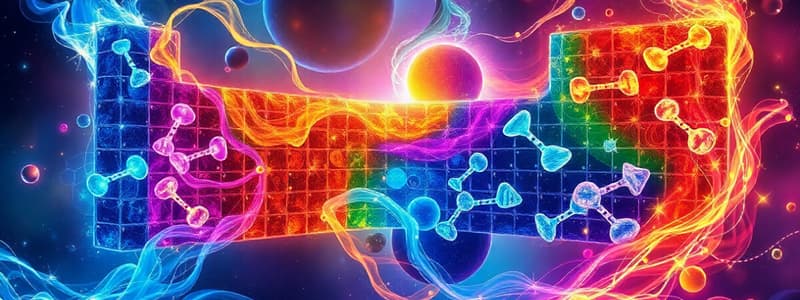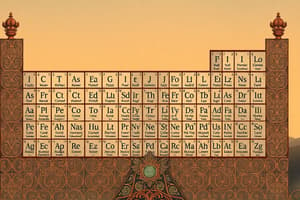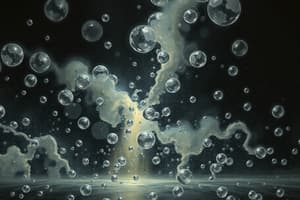Podcast
Questions and Answers
What term is used to describe the rows in the Periodic Table?
What term is used to describe the rows in the Periodic Table?
- Groups
- Columns
- Periods (correct)
- Families
Which property is typically associated with metals?
Which property is typically associated with metals?
- Shiny and good conductors of heat and electricity (correct)
- Ductile and can shatter easily
- Gaseous at room temperature
- Brittle and poor conductors
What describes the elements found in Groups 1A and 2A of the Periodic Table?
What describes the elements found in Groups 1A and 2A of the Periodic Table?
- Noble gases
- Transition metals
- Inner transition metals
- Main Group elements (correct)
Which characteristics are most associated with metalloids?
Which characteristics are most associated with metalloids?
Which group contains elements that are typically poor conductors and can shatter easily?
Which group contains elements that are typically poor conductors and can shatter easily?
How are elements organized in the Periodic Table?
How are elements organized in the Periodic Table?
Which statement best describes metalloids?
Which statement best describes metalloids?
What is a common property of alkali metals?
What is a common property of alkali metals?
How does the reactivity of alkali metals change down the group?
How does the reactivity of alkali metals change down the group?
Which element is known to be a metalloid?
Which element is known to be a metalloid?
Which group of elements is known as salt-forming elements?
Which group of elements is known as salt-forming elements?
What is a defining feature of non-metals?
What is a defining feature of non-metals?
Where can alkali metals typically be found?
Where can alkali metals typically be found?
What characteristic is shared by halogens?
What characteristic is shared by halogens?
Which property is NOT typical of metals?
Which property is NOT typical of metals?
What primarily distinguishes the arrangement of columns in the Periodic Table?
What primarily distinguishes the arrangement of columns in the Periodic Table?
Which of the following is a characteristic typical of non-metals?
Which of the following is a characteristic typical of non-metals?
What defines transition metals in the Periodic Table?
What defines transition metals in the Periodic Table?
Which description fits the group of elements known as metalloids?
Which description fits the group of elements known as metalloids?
In which area of the Periodic Table would you primarily find soft metals?
In which area of the Periodic Table would you primarily find soft metals?
What happens to alkali metals when they are placed in water?
What happens to alkali metals when they are placed in water?
Which of the following is a characteristic of alkaline-earth metals compared to alkali metals?
Which of the following is a characteristic of alkaline-earth metals compared to alkali metals?
Which of the following diatomic elements is part of the halogen group?
Which of the following diatomic elements is part of the halogen group?
What is the primary function of the elements found in Group 6A (Chalcogens)?
What is the primary function of the elements found in Group 6A (Chalcogens)?
Which alkali metal is known to catch on fire when reacting with water?
Which alkali metal is known to catch on fire when reacting with water?
What defines the regions of space around the nucleus where it is likely to find electrons?
What defines the regions of space around the nucleus where it is likely to find electrons?
Which quantum number is associated with the shape of an orbital?
Which quantum number is associated with the shape of an orbital?
As you move away from the nucleus, what happens to the probability of finding an electron?
As you move away from the nucleus, what happens to the probability of finding an electron?
Which quantum number provides information on the orientation of an orbital in three-dimensional space?
Which quantum number provides information on the orientation of an orbital in three-dimensional space?
How does the size of p orbitals change as the principal quantum number increases?
How does the size of p orbitals change as the principal quantum number increases?
What is the mass number of an element's isotope if it contains 10 neutrons and 9 protons?
What is the mass number of an element's isotope if it contains 10 neutrons and 9 protons?
Which of the following statements is true regarding isotopes?
Which of the following statements is true regarding isotopes?
What is the average atomic mass of an element with two isotopes having masses of 20.00 amu and 22.00 amu with natural abundances of 40% and 60% respectively?
What is the average atomic mass of an element with two isotopes having masses of 20.00 amu and 22.00 amu with natural abundances of 40% and 60% respectively?
What does the electronic structure of an atom primarily determine?
What does the electronic structure of an atom primarily determine?
Which principle is crucial for understanding electron behavior in atoms?
Which principle is crucial for understanding electron behavior in atoms?
Study Notes
Chemistry
- The study of matter and its transformations.
Elements
- Most basic form of matter.
- Cannot be broken down further by chemical means.
Periodic Table
- Organizes elements based on their chemical properties.
- Rows are called periods, elements within are chemically unrelated.
- Columns are called groups, elements within share similar properties.
- Left side: Soft metals (first two columns).
- Middle: Transition metals (yellow).
- Green: More metals.
- Blue: Semimetals (metalloids).
- Right side: Non-metals (blue, purple, mauve).
- Main group elements: Groups 1A, 2A (left), 3A to 8A (right).
- Transition metals: Groups 1B to 8B (middle).
Element Categories
- Metals: Shiny, excellent heat and electricity conductors.
- Except: Mercury (Hg) which is a liquid.
- Malleable: Can be pounded into sheets.
- Ductile: Can be drawn into wires.
- Non-metals: Gases, liquids, or brittle solids.
- Poor conductors of heat and electricity.
- Metalloids: Properties between metals and non-metals.
Polyatomic Elements
- Most elements exist as single atoms (monatomic).
- Seven elements exist as diatomic molecules (two atoms bonded).
- Others can exist in polyatomic forms (more than two atoms bonded).
- Phosphorus (P) is found in both tetratomic (P4) and monatomic (P) forms.
Group 1A - Alkali Metals
- React violently with water.
- Hydrogen gas is produced, often catching fire due to the heat released.
- Reactivity increases as you move down the group.
- Lithium (Li) floats.
- Sodium (Na) catches fire.
- Cesium (Cs) explodes.
- Francium (Fr) is radioactive and rarely used.
Group 2A - Alkaline Earth Metals
- Also react with water, producing hydrogen gas and an alkaline solution.
- Less reactive than alkali metals.
- Found in rocks in Earth's mantle.
- Reactivity increases down the group.
- Important elements for health (magnesium and calcium).
Group 6A - Chalcogens
- "Chalco" means copper.
- Copper ores contain copper combined with these elements.
- "Gen" refers to generating copper metal through chemical treatment.
Group 7A - Halogens
- "Halo" means salt.
- Combine with metals to form salts (e.g., NaCl).
- Exist as diatomic elements (two atoms bonded).
Group 8A - Noble Gases
- Chemically inert, meaning they do not readily react with other elements.
- Have various applications.
Diatomic Elements
- Hydrogen (H2), Nitrogen (N2), Oxygen (O2), Fluorine (F2), Chlorine (Cl2), Bromine (Br2), Iodine (I2).
Triatomic Elements
- Ozone (O3).
Polyatomic Elements
- Red phosphorus (P4).
- Orthorhombic sulfur (S8).
Chemistry
- Chemistry describes matter and its transformations.
- The periodic table is a logical arrangement of elements based on chemical properties.
The Periodic Table
- Contains all known elements
- Rows are called periods, elements in a period are chemically unrelated
- Columns are called groups, elements in a group are chemically similar,
- Main group elements are in groups 1A, 2A, and 3A to 8A
- Transition metals are in groups 1B to 8B
- Left-hand side of the Periodic Table contains soft metals
- Transition metals are in the middle section
- More metals appear in green
- Metalloids appear in an aqua-blue diagonal section
- Non-metals appear in light-blue, mauve, and purple colors on the right-hand side of the table.
Element Categories
- Metals are shiny, good conductors, malleable, and ductile.
- Most metals are solid, except for Mercury (Hg)
- Non-metals can be gases, liquids, or solids.
- They are brittle, poor conductors of heat and electricity.
- Metalloids have properties of both metals and non-metals.
Polyatomic Elements
- Most Elements are monatomic.
- Seven elements are diatomic: H2, N2, O2, F2, Cl2, Br2, I2.
- Triatomic element is Ozone (O3)
- Polyatomic elements include Phosphorus (P4) and Sulfur (S8)
Group 1A – Alkali Metals
- React violently with water, some catching fire.
- Reactivity increases as you go down the group.
- Lithium (Li) floats in water, Sodium (Na) catches fire, Cesium (Cs) explodes in water.
- Francium (Fr) is radioactive.
- Hydrogen is in group 1A but is not considered an Alkali Metal.
Group 2A – Alkaline Earth Metals
- React with water, producing hydrogen gas and an alkaline solution.
- Less reactive than alkali metals.
- Reactivity increases going down the group.
- Magnesium (Mg) and Calcium (Ca) are important for human health.
- Radium (Ra) is radioactive.
Group 6A – Chalcogens
- Called Chalcogens because they are found in copper ores.
- Copper metal is produced through chemical treatment.
Group 7A – Halogens
- Halogens mean “salt-forming.”
- Halogens form salts when combined with metals.
- Halogens exist as diatomic elements.
- Fluorine (F) is the most reactive Halogen.
- Astatine (At) is radioactive.
- Fluorine and chlorine are toxic gases when inhaled.
- Bromine (Br) is an orange-brown volatile liquid.
- Iodine (I) is a black solid, turning to purple vapor when heated.
Group 8A – Noble Gases
- Also known as inert gases or rare gases.
- They are very unreactive.
- Their main source is the atmosphere.
- Helium (He) is used in balloons.
- Neon (Ne) is used in advertising signs.
- Radon (Rn) is radioactive and causes lung cancer.
- Noble gases are unreactive except under extreme conditions.
- Reactivity increases down the group.
Electrons as Waves
- Electrons behave as waves and can be described by the Schrödinger Equation
- Solutions to the Schrödinger Equation define regions of space around the nucleus where electrons are likely to be found, called orbitals
- Orbitals have unique shape, size, and 3D orientation
- Orbital shapes are described by the angular momentum quantum number (l)
- Orbital size is described by the principal quantum number (n)
- Orbital orientation is described by the magnetic quantum number (ml)
- Quantum numbers provide numerical descriptions of orbital properties
- Orbitals can be thought of as electron cloud formations
The Atom
- Atoms consist of a positively charged nucleus and negatively charged electrons surrounding it
- The nucleus contains protons (positively charged) and neutrons (no charge)
- Coulomb's Law states that opposite charges attract, so electrons are attracted to the positive nucleus
- As an electron moves further from the nucleus, more energy is required due to the attraction between the electron and the nucleus.
- The electron density surrounding the nucleus decreases with distance from the nucleus
Atomic Structure
- Atomic Number (Z): number of protons in an atom, unique to each element
- Mass Number (A): total number of protons and neutrons in an atom
- Isotopes: atoms of the same element with the same atomic number but different mass numbers (different number of neutrons)
- Natural Abundance: percentage of a particular isotope in nature
- Stable Isotopes: isotopes with a long half-life
- Unstable (Radioactive) Isotopes: isotopes with a short half-life, decay over time
- Half-life: time taken for half the radioactive isotopes to decay
- Carbon-14: radioactive isotope with a half-life of 5,730 years, used in carbon dating
- Average Atomic Mass (AAM): weighted average of the masses of all isotopes of an element, taking into account their natural abundances
Electronic Structure
- Electronic Structure: arrangement of electrons in an atom, determines its chemical behavior
- Quantum Mechanics: branch of science that describes the behaviour of matter at the atomic and subatomic level
- Quantum Mechanical Model: provides a more accurate description of the atom than the simple model of electrons orbiting the nucleus
- Electron Cloud Model: describes the probability of finding electrons in specific regions of space around the nucleus
Quantum Numbers
- Quantum Numbers: describe the properties of orbitals
- Principal Quantum Number (n): determines the size of an orbital, higher n means larger size
- Angular Momentum Quantum Number (l): determines the shape of an orbital:
- l = 0: s orbitals, spherical shape
- l = 1: p orbitals, dumbbell shape
- l = 2: d orbitals, more complex shapes
- Magnetic Quantum Number (ml): determines the orientation of an orbital in space, different values of ml correspond to different orientations of the same type of orbital (e.g., px, py, pz for p orbitals)
- Spin Quantum Number (ms): describes the spin of an electron, which is quantized and can be either spin up (+1/2) or spin down (-1/2)
Studying That Suits You
Use AI to generate personalized quizzes and flashcards to suit your learning preferences.
Related Documents
Description
Explore the fundamental concepts of chemistry with a focus on elements and their classification within the periodic table. Understand the organization of elements into groups and periods, and learn about the distinct properties of metals, non-metals, and more. This quiz will test your knowledge on matter transformations and the characteristics of various elements.




